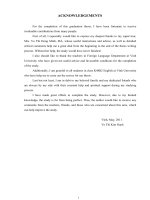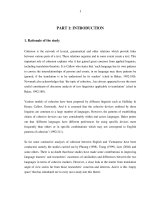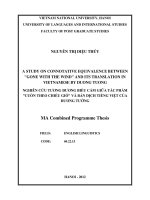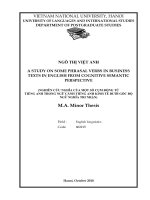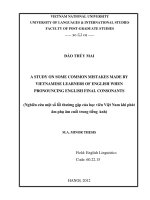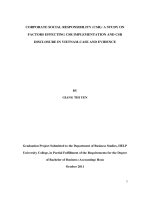A study on some english negative structures and their vietnamese equivelents in gone with the wind
Bạn đang xem bản rút gọn của tài liệu. Xem và tải ngay bản đầy đủ của tài liệu tại đây (1.59 MB, 78 trang )
MINISTRY OF EDUCATION AND TRAINING
HANOI OPEN UNIVERSITY
NGUYEN THI TUYET
A STUDY ON SOME ENGLISH NEGATIVE STRUCTURES AND
THEIR VIETNAMESE EQUIVALENTS IN ‘GONE WITH THE WIND’
NGHIÊN CỨU MỘT SỐ CẤU TRÚC PHỦ ĐỊNH TRONG TIẾNG ANH
VÀ NHỮNG TƯƠNG ĐƯƠNG TIẾNG VIỆT TRONG TIỂU THUYẾT
‘CUỐN THEO CHIỀU GIÓ’
M.A. THESIS
Field: English Language
Code: 60220201
Supervisor: Nguyen Dang Suu, Ph.D
Hanoi - 2013
ACKNOWLEDGEMENTS
For the completion of this work, I have been fortunate to receive invaluable
contributions from many people. First of all, I would like to express my
deepest gratitude to my supervisor, Dr. Nguyen Dang Suu for his
indispensable assistance, excellent suggestions, expert advice and detailed
critical comments, without which the work would not have been complete.
In addition, I am greatly indebted to all my lecturers at Hanoi Open
University for their constant support and encouragement.
I would also like to extend my sincere thanks to my family and my friends for
their unconditional support, encouragement and forbearance.
Finally, I am all too aware that despite all the advice and assistance, I feel that
the project is far from perfect; it is, therefore, my sole responsibility for any
inadequacies and shortcomings that the thesis may be considered to have.
i
DECLARATION
I hereby declare that no part of the enclosed Master Thesis has been copied or
reproduced by me from any other’s work without acknowledgement and that
the thesis is originally written by me under strict guidance of my supervisor.
Hanoi, December 30, 2013
Nguyễn Thị Tuyết
APPROVED BY:
ii
ABREVIATIONS
A: adverbial
Adj: adjective
Aux. Auxialiary
C: complement
Noun: noun
NP: noun phrase
O: object
S: subject
V: verb
Pr: Predicate
BN: Bổ ngữ
CN: Chủ ngữ
DT: Danh từ
ĐT: Động từ
TN: Tân ngữ
TrN: Trạng ngữ
VT: Vị thể
iii
TABLE OF
CONTENTS
ACKNOWLEDGEMENTS
DECLARATION i
ABREVIATIONS ii
ABSTRACT 1
PART A: INTRODUCTION TO THE STUDY 2
1. Rationale of the study 2
2. Aims of the study 2
3. Research questions 2
4. Scope of the study 3
5. Methods of the study 3
6. Design of the study 4
PART B: DEVELOPMENT 5
CHAPTER ONE: THEORETICAL BACKGROUND 5
1.1. Review of the previous studies. 5
1.2. Theoretical Background: 6
1.2.1. Overview of negation. 6
1.2.2. Characteristics of negation 7
1.2.3. Negation under some linguists’ viewpoint 12
1.2.4. Negation in Vietnamese in brief 15
CHAPTER TWO: THE COMPARISION OF SYNTACTIC STRUCTURES OF
NEGATION BETWEEN ENGLISH AND VIETNAMESE 19
2.1. Stuctures of negative statements 19
2.1.1. Subject negation: 19
2.1.2. Predicate negation 21
2.1.3. Object negation 29
2.1.4. Complement negation 30
2.1.5. Adverbial negation 31
2.1.6. Clause negation 32
iv
2.1.7. Total negation 34
2.2. Negative questions 35
2.2.1. Negative Yes-No questions 35
2.2.2. Negative Wh- questions 36
2.2.3. Question tags 37
2.3. Negative commands 37
CHAPTER THREE: FINDINGS AND DISCUSSION OF THE STRUCTURES
OF NEGATION IN “GONE WITH THE WIND” AND THEIR VIETNAMESE
EQUIVALENTS 39
3.1. The structures of negations used in ‘Gone with the wind’ 39
3.1.1. The frequency of using the negators in the novel and in translated version 39
3.1.2. The frequency of using “NOT” in the novel 39
3.1.3. The frequency of using “NO” in the novel 43
3.1.4. Negation with NOT … ANY, NOT…… EITHER, NOT ….EVER in the novel 45
3.2. Syntactic features of negative sentences in the source language and the
translated version in the target language 46
3.2.1. Negative statements in the novel 47
3.2.2. Negative questions in the novel 62
3.2.3. Negative commands in the novel 64
3.3. Similarities and differences of English syntactic negative structures in
‘Gone with the Wind’ and their Vietnamese translations 65
3.3.1. Similarities 65
3.3.2. Differences 67
PART C – CONCLUSION 68
1. A brief summary of the thesis and main conclusions 68
2. Limitations of the study 68
3. Suggestions for further studies 69
REFERENCES 70
v
TABLES AND FIGURES
Table1. The frequency of using modal verb with ‘not” in negative structures
in the novel 42
Table 2. The frequency of using negators “không” and “chẳng” in translated version 46
Table 3. Negative structure in the source language text and the target source one 46
Figure 1. The frequency using “not” in different parts in the sentence 43
Figure 2. The frequency of using “no” in different parts in the sentence 44
Figure 3. The frequency of using negators in translated version 45
1
ABSTRACT
Negation is present in all human languages; it is one of the prevalent and
fundamental features of any human languages. As Larry Horn observes in his “A
Natural History of Negation” that all human systems of communication contain a
representation of negation. No animal communication system includes negative
utterances, and consequently none possesses a means for assigning truth value, for
lying, for irony, or for coping with false or contradictory statements
(Horn2001: iii). In English, especially in the novels, negative sentences account for
not a small proportion. Much attention has been paid to the patterns and semantic of
negative sentences. However, there has been no investigation into a particular literal
work so far. For this reason, the study aims at pointing out the syntactic differences
and the similarities between negation in Vietnamese and English and analyzing
some negative structures from the novel “Gone with the Wind” by Margaret
Mitchell and its equivalents in the translated version by Duong Tuong in an attempt
to clarify the negative structures in English and Vietnamese equivalents.
2
PART A: INTRODUCTION TO THE STUDY
1. Rationale of the study
Negation is a topic that is widely discussed within semantics, pragmatics,
morphology, and syntax. In general, English and Vietnamese have similar features
in terms of expressing negation. However, a profound analysis shows that each
language has its own chracteristics making some differences in comparison with
other languages. Negative syntactic structures in English and Vietnamese are
considered to be one of the most interesting and difficult issues that require a great
attention in learning English as a foreign language.It is the structures that may cause
difficulties for learners in communicating English and Vietnamese. Therefore, this
study describes, analyses and compares negation between English and Vietnamese
in terms of structures. In addition, the investigation into negation in “Gone with the
Wind” and its Vietnamese version translated by Duong Tuong is conducted in an
attempt to demonstrate how negative sentences are formed in this novel. Hopefully,
it will benefit people who have an interest in this thesis.
2. Aims of the study
This study mainly focuses on:
Describing and classifying how negative structures of English and Vietnamese are built
and used in details. Making a comparison of English negation with Vietnamese one.
Carrying out an investigation into the structures of expressing negation in the novel
“Gone with the Wind” by American writer Margaret Mitchel and its translated
version “Cuốn the chiều gió” by Duong Tuong.
3. Research questions
The following are the four research questions:
-What are the brief features of negation in English and Vietnamese?
- What are the syntactic similarities and differences between negative structures in
English and Vietnamese?
- How are negative ideas expressed in the novel “Gone with the Wind” and its
translated version?
3
4. Scope of the study
Firstly, the theoretical background of the study focuses on some fundamental issues
in negation, which is of vital importance of the study.
Secondly, the research focuses on negation equivalence in the novel: “Gone with
the Wind” by Margaret Mitchell and the Vietnamese translated version by Duong
Tuong. The research questions in the preceding part have already implied that the
research is focused on negation in the novel “Gone with the Wind” rather than in
the other literary works. To be more specific, the study will examine the similarities
and differences between negation in English and Vietnamese. However, since
negation is a very big issue, this study mainly examines syntactic features of
English negative sentences that contain the formal makers of negation such as
not, no, nobody/no one, nothing, nowhere, none, never, neither/nor in the novel
“Gone with the Wind” and their Vietnamese equivalents in translated version
“Cuốn theo chiều gió”
Beside the novel “Gone with the Wind” by Margaret Mitchel and its translated
version “Cuốn theo chiều gió” by Dương Tường”, the sources of data are also taken
from the other novels such as: The Vanity Fair by Tharkeray and its Vietnamese
translated version Hội chợ phù hoa by Trần Kiêm , The Old Man and the Sea by
Ernest Hemingway and the translated version “ Ông già và biển cả” by Huy
Phương.
5. Methods of the study
The contrastive method is mainly used in the thesis to analyze the ways of
expressing negative ideas in English and Vietnamese.
The main research methods include three techniques namely (1) description, (2)
translation and (3) deduction. The descriptive and deductive approach is applied in
the theory revision to come to the nature of negation in English and Vietnamese.
Data randomly collected are qualitatively and quantitatively analyzed on the
basis of grammatical and pragmatic theories.
4
6. Design of the study
The study is divided into three parts
Part A is the Introduction of the study. It includes the rationale for choosing the
topic, the aims, the methods and design of the study.
Part B consists of three chapters: Chapter one presents some theoretical background
on negation in which the contrastive study of negation in English and Vietnamese is
described. Chapter two presents the comparision of syntactic negative structures
between English and Vietnamese. Chapter three investigates how negative
structures are used in the novel “Gone with the Wind” and its translated version.
Part C gives out a review of the study and some suggestions for further study.
5
PART B: DEVELOPMENT
CHAPTER ONE: THEORETICAL BACKGROUND
1.1. Review of the previous studies.
Jesperson (1917) in “Negation in English and Other Languages” paves the ways for
studies of negation later. He provides the readers with general tendencies of
negation, strengthened and weakened negatives, indirect and incomplete negation
and the meaning of negation. He also shows that negation can be complete with
nuclear negators like not, no, never, or incomplete with semi-negations as hardly,
scarcely, little, few. Among them “NOT” is followed by auxiliary verbs to negate
the whole sentence.
Klima’s (1964) supplies a wide variety of sentences that are superficially quite
distinct “negative” words such as “not”, “none”, “never”. He is trying to show
several criteria for differentiating a class of “negative sentences”. His approach is a
syntactic approach aimed at grammatical correctness and proper use of the negation.
Lake off (1965) was another linguist who looked at negation syntactically and
differed from Klima in certain areas. He raised some main objections, but his
finding or proposition are not as far reaching or all encompassing in relation to
negation and a bit ambiguous.
Tot Tie (1991) puts forward a classification of the uses of negatives in both oral
and written language in “Negation in English Speech and Writing”. Pagan (1990)
shows the pragmatic perspective of “Negatives in Written Text”. Horn, Laurence,
R. and Yasuhiko Kato (2000) in “Negation and Polarity. Syntactic and Semantic
Perspectives” give out the syntactic features and scope of negation. Mazzon in “A
History of English Negation” concerns about an extensive study of negation that
combines both synchronic and diachronic complementary analyses. Vietnamese
grammarians and linguists have investigated into negation from difference
perspectives but mainly focus on traditional, structural or logical perspectives such
as Hoàng Trọng Phiến (1980), Nguyễn Đức Dân (1996), Đỗ Thị Kim Liên (1999)
Diệp Quang Ban (2004, 2006), Mai Ngọc Chu, Vũ Đức Nghiệu. In addition,
6
Nguyen Quang has also investigated negative sentences in English and Vietnamese
on a contrastive analysis in his master thesis. Especially, Tran Van Phuoc in his
doctoral thesis “Phân tích đối chiếu câu phủ định tiếng Anh và tiếng Việt trên bình
diện cấu trúc ngữ nghĩa” systemized the syntactic-semantic features both in English
and Vietnamese declarative sentences as well as analyzed the differences and
similarities of syntactic-semantic features in the two languages. He suggests 17-
negative sentence structures and 61 variations in English as well as 64 variations in
Vietnamese. Then Ms Tran Phuong Thao from Danang University conducted “An
Investigation into English Lexical Devices Denoting Negation versus Vietnamese
Equivalents” (2010), in which the ways that express the conception of negation in
English and Vietnamese equivalents are clarified. All those books and studies have
revealed typical and very interesting features of negation in general as well as
negation in English and Vietnamese in particular. However, there has been no
investigation on a particular novel so far. Therefore, the investigation into negation
in “Gone with the Wind” is conducted in an attempt to prove how syntactic negative
structures are used and translated into Vietnamese by Duong Tuong.
1.2. Theoretical Background:
This chapter offers some theoretical background on negation in English and in
Vietnamese in brief, to which the study related.
1.2.1. Overview of negation.
There have been many definitions of negation in English. In the Longman
Dictionary of Language Teaching and Applied Linguistics, negation is defined as
“contradicting the meaning or part of the meaning of sentences.”
Horn (2010) gives out the definition about negation: “In many ways, negation is
what makes us human, imbuing us with the capacity to deny, contradict,
misrepresent, lie, and convey irony.” Lindstadd (2007,1) argues, “Negation is a
language universal, found in all known languages, and unique to human
languages”. A further uniform characteristic is that sentential negation (including
7
what could be termed “clausal negation
‟
) always involves “the addition of an overt
morpheme to an affirmative clause” (Lindstad 2007; p.24). The function of negation
is fairly straightforward: it negates parts of or the entire sentence or clause.
And Longman Dictionary of Contemporary English, published in 1994 shares the
same and adds some more information that “Negation is the act of stating that
something does not exist or is untrue”,furthermore the Vietnamese Dictionary,
published in 1998 by the Centre of dictionary and Danang Publishing House says
that negation is the act of rejecting the existence, the necessity of something; the
opposition of affirmation. Collins Cobuilt (Collins Cobuild, 1990, p.206) concludes,
“Negation is used when you want to say something is not true, is not happening, or
not the case”.
Although there is wide variety of definition of negation, I myself totally agree to
some main points as follows:
Negation is a part of people’s cognition activity and communication process. It is a
basic category of thinking, of formal logic. It is the opposition of the affirmative
category.
1.2.2. Characteristics of negation
Huddleson and Pullum (2002) provide a very clear description on the characteristics
of negation in English.
Unlike affirmation, negation can be identified by words. (e.g., not, no, never) or
affixes (e.g., dis, un-). Negation can interact with other words in special ways. For
example, negated clauses use more different connective adjuncts than positive
clauses do: neither, nor instead of either, or. The so-called negatively oriented
polarity-sensitive items (Huddleston and Plum 2002) contain among many others,
words starting with any-(anybody, anyone, anywhere, etc.), the modal auxiliaries
dare and need and the grammatical units at all, much and until. Negation in verbs
usually requires an auxiliary; if “none” is present, the auxiliary do is inserted (I
read the paper vs I didn’t read the paper).
8
1.2.2.1. Scope of negation
Negation is exclusive to humans and can be used for different purposes: reverse the
polarity of a statement (eg. She didn’t see him), emphasize how great or extreme
something is (eg. “It was nothing less than a disaster”) or make weaker claims (eg.
Her husband character is not good). Negated statements often carry positive
meaning beneath the direct meaning and detect precious knowledge. For instance,
Peter didn’t go to Moscow to relax, a reader will interpret that Peter went to
Moscow but his purpose is not to relax.
Huddleston and Pullum (2002) state that the scope is made up with the part of the
meaning that is being negated and the focus is that part of the scope that is most
prominently or explicitly negated.
“The scope of the negation normally extends from the negative word itself to the
end of the clause, or to the beginning of a final adjunct”. (Quick, p.187)
In the view of Eagleson, the part of a sentence or clause that is controlled by “not”
or other negative words is called the scope of negation.
The scope of negation is mentioned to indicate the stretch of language over which
the negative has its effect. The relation between negative words and non-assertive
words that they govern will happen in scope of negation (that is part of language
that the negative meaning operates through). The scope of negation formally extents
from the negative words to the end of the clause or to the beginning of a final
adjunct. The subject and any adjuncts occur before a final predication often lies
outside it. Hence, the operator can be within or outside the scope. Some following
examples are given for illustration:
E.g.: I definitely didn’t speak to him. (1)(Quirk,p.188)
Versus I didn’t definitely speak to him (2) ( Quirk, p.188)
In (1), the scope of negation stretches from “not” to “him”, subject (I), adjunct
(definetely), operator (did) are excluded, the predication takes full negative effect
(1) = It’s definite that I did not speak to him
9
Sentence (2) “I” and operator “did” are put outside while adjunct is inside, negative
meaning extends from negative word to the end of the clause. It’s not definitely that
I did.
The scope of negation also extends to the beginning of a final adjunct.
E.g.: She did not arrive at school in the morning (3)
Versus: She did not arrive at school in the morning (4)
In two examples above, final adjunct as adverbial maybe within and outside scope:
(3) It is not true that he arrived at school in the morning.
(4) In the morning, she did not arrive at school.
However, when an adverbial is in the final position, it may or may not lie outside
the scope.
eg. I wasn’t listening all the time ( ie. I listened none of the time)
and I wasn’t listening all the time. (ie I listened some of the time).
When assertive forms are used, it must lie outside the scope.
Eg.I didn’t listen to some of the speakers (ie I listened to some)
I didn’t listen to some of the speakers. (ie I listened to none)
The negative clause that has adjunct is ambiguous to interpret.Since adjuncts are
optional elements and they have no fixed positions, the listeners may understand the
negative meaning in their own ways.
The scope of negation only works with non-assertive forms. In the negative with
assertive forms, the scope does not include them. It is because the assertive forms
do not exert negative effect.
E.g.: He did not do some exercises ≈ He did some exercises.
He did not do any exercises ≈ He did no exercises.
A negative with assertive-form implies another affirmative or is regarded as “partial
negative”.
Apart from adverbials, the ambiguity is also made by an operator in a negative,
here, operator is not a normal auxiliary expressing grammatical function, but a
modal auxiliary. With a negative modal auxiliary, verb phrase falls into a situation
10
that the negation belongs to main verb or auxiliary, the interpretation of the negative
depends on the negative meaning of modal auxiliaries themselves.
1.2.2.2. Focus of negation
Beside the scope, the focus of negation is also needed to incorporate. Focus of
negation places a stress on particular part of a negative clause, which helps to make
the notice of the contrast of meaning implicited in the negative, at the same time
indicates the rest of the clause in the positive. The focus in a negative clause may be
the subject, the main verb, the object, the complement, the adjunct or any words or
phrases under the constrative stress. In other words, the focus of negation is to place
effect on single word, which belongs to either open-class item in clause.
Grammatically, the focus of negation in English is devided into two types: end-
focus and contrastive focus.
End-focus
Richard Nordquist states that “End- focus is the principle that most important
imformation in a clause or sentence is placed at the end. It is a normal characteristic
of sentence structures in English. (Richard, About.com Grammar and Composition)
Mentioning the definition of end focus, Quirk (1974; 407) states that end - focus
is the chief prominence on the last- open items (verbs, adjectives, nouns, adverbs)
and proper noun. "To
be technically accurate, end focus is given to the last open-
class item or proper noun in a clause”
(
Quirk and Greenbaum 1973). In other words,
the end focus is used to withdraw hearer’s attention to information that speaker
wants to convey; when a negative clause has end-focus, only last item is negated the
rest is positive.
E.g.: She wasn’t in her office ≈ (She was somewhere, not in her office)
They haven’t been to Ho Chi Minh City ≈ (They have gone somewhere,
but not to Ho Chi Minh City)
11
Contrastive-focus
Special or contrastive focus may be placed at earlier points and falls on any of
the non-final elements of the clause or final item, which belongs to closed-system
items (prepositions, pronouns, etc ). Using contrastive focus, only one item is
negated and the rest of clause is understood in positive sense.
E.g.: “John did not phone Jane yesterday”.
≈ (Someone phoned Jane yesterday not John)
John did not phone Jane yesterday.
≈ (John phoned someone yesterday, but not Jane.)
The contrastive focus indicates which element is negated in a clause to contrast it
with something or somebody already mentioned. Contrastive focus falls on a final
item, but not end-focus.
E.g.: “She is not waiting for `me” ≈ (She is waiting for someone, not me)
His father was not `out ≈ (He was in)
Operator also gets a contrastive focus, which places contrastive emphasis on tense.
E.g.: “She `didn’t study English two years ago”. (Now, she is learning
English)
Operator is used in elliptical replies to concentrate attention on new information by
avoiding repetition of given information.
E.g.: “ Have you phoned your parents?” -“No, I ` haven’t.” ≈ (I haven’t
phoned my parents)
“ Did you go out last night?” “No, I `didn’t.” ≈ (I didn’t go out last night)
The participation of end focus and a contrastive focus makes the focus of negation
not as ambiguous as the scope of negations they also have a certain contribution to
finding appropriate account for ambiguity in the scope of negation.
1.2.2.3. The relationship between scope and focus of negation
The scope and focus are so interrelated that the scope must be inside the focus.
Scope is connected to all elements whose individual falsity would make the negated
statement strictly true. Focus is the element of the scope that is intended to be
12
interpreted as false to make the overall negative true. In other words, they are
interconnected in such a way that the scope must include the focus. In an
independent clause the scope of negation covers all the negative effect.The extent of
the scope is identified by the position of the focus. Indeed, since the scope of
negation is often not clearly signaled, “we can indicate it by where we place the
information focus”(Quirk,188) The following is an example of the scope of
negation which is extended to include a subordinate clause of reason, with a
contrastive fall-rise to emphasize this:
“I didn’t leave HOME because I was afraid of my FATHER”.
(Quick, P.189)
(The information focus is on “ didn’t leave home”
(= Because I was afraid of my father, I didn’t leave home.)
“I didn’t leave HOME because I was a afraid of my FATHER”.
(The information focus is on “didn’t leave home because I was a afraid of my
father” (It means I left home, but it wasn’t because I was afraid of my father.)
In this case, intonation may be crucial in making the extension of the scope
backwards to include the subject: an occasional phenomenon found in subjects
which contain one of the “universal” terms “all’ and “every”.
ALL cats don’t like WATER ( i.e.” All cats dislike water”)
(In this case “don’t like water” is emphasized.)
ALL cats don’t like WATER (not all cats like water) (The negative meaning
operates “ALL cats don’t like WATER”( Quirk, p.187)
1.2.3. Negation under some linguists’ viewpoint
1.2.3.1. According to the Longman Dictionary of Language Teaching and
Applied Linguistics:
The dictionary shows that “The main negator (negator is a word that makes a
negative sentence”) is “not”, often in its contracted form “n’t” and combined with
an auxiliary, for example:
13
isn’t going/ hasn’t gone/ didn’t go/ doesn’t want to go.
But there are other negators such as: “hardly ever”, “never”, “seldom”, “neither”,
“nothing”.
Eg. Although he lived quite close, he never visited us.
Besides, negation can be expressed by negative pronouns, e.g. :
“There was nobody there”.
Or by negative affixes,e.g.:
“That was unkind!”
Some varieties of English may be DOUBLE NEGATIVE, such as:
“I haven’t done nothing”.
Double negation is merely used for emphasis. Often double negation is frowned on
as being non-standard. However, it is typically used in a number of English Dialects
and it follows a definite pattern, e.g. the use of no instead of any in the following
example:
“We didn’t hurt nobody!”
In recent grammatical theory, interest has been shown in the scope of the negator,
that is, how much of the sentence is actually negated and in what way the meaning
of the sentence can change if the negator is put in a different place, for instance, two
sentences: “She didn’t think he could do it” and :“ She thought he couldn’t do it”
do not really mean the same.
1.2.3.2. In “Negation in English” by Klima
Klima (1964), presents certain criteria in identifying negative structures. His
emphasis was on the transitional “not”. He determined over some patterns of the
negative and exemplified as below:
Pattern1: Superficial negatives: not, none, never.
Pattern2: Not+ negative word: didn’t, no one, was not.
Pattern3: Tag questions+ falling intonation on the tag:
E.g.: “You have been to New York, haven’t you?”
“Mary isn’t going to school today, isn’t she?”
14
Pattern4: Not- even tags permissible in only negative sentences:
“No one ate the food, not even the dog”.
Pattern5: Either- conjoining sentences:
“I didn’t see Mary this morning and Tom didn’t either”.
Pattern6: Neither tags: “The children shouldn’t take that medicine, and neither
should she”
Pattern7: Incomplete negative: hardly, scarcely, rarely, seldom.
1.2.3.3. Halliday and Hassan
Halliday and Hassan (1976) looked at the issue of negation and polarity. They
pointed out that polarity is normally expressed at the beginning of the verbal group.
A negative verbal group will have “n’t” or “not” attached to the first word if it is
finite e.g. “could not come”. If it is non-finite, it has not; it usually appears as the
first word e.g. not having eating, not to have eaten. Other negative adverbs like
“never’, hardly”, hardly ever” may occur in place of “not”.
According to their findings, the category of negative is not clearly defined, but is
revealed by the choice of tag.
1.2.3.4. Quirk et al (1973)
Quirk et al (1973) keeps the opinion of negative sentences entailing the
operator, requiring the insertion of “not” (or in its contracted form “n’t”) between
the operator and the predication. His makes intensive contributions to the study of
negation. He discovers the ambiguity in negation as well as the similarity between
questions and negations. Quirk et al also states that questions like statements can be
positive or negative.
Moreover, negative preposition such as from, off, out of were also identified.
According to Quirk et al, those prepositions may be defined by simply adding the
word “not” to the corresponding positive preposition.
E.g.: “She was away from work for a week”.
= “She was not at work for a week”.
15
Especially, Quirk et al are among the few who have looked into this area and they
say most disjuncts can be modified and several can be premodified by “not”,
especially “surprising” and some with negative prefixes (unexpectedly,
unreasonably, unwisely, unusually).
Quirk et al also examines the transfer of the negative form a subordinate that-clause,
which it belongs to the main clauses semantically.
E.g.: “I don’t believe he is right”
can be transferred to: “I believe he isn’t right”.
This kind of transfer is limited to verbs of belief of assumption, eg. “Think, believe,
suppose, fancy, expect, imagine and reckon”.
He proposes assertive and non-assertive negatives as the table below:
Table 1:
S/No Syntactic Assertive Non- assertive Negative
1. Determiner Some(one or
the other)
Any no
2 Determiner One or the
other
Either Neither
3. Pronoun Some Any None
4. Pronoun One or the
other
Either Neither
He also provides the overview of negative structures (including predicate, subject,
complement and adverbial negation.
Among those linguists is Quirk et al. In the next part, his concept and characteristics
of negation will be described.
1.2.4. Negation in Vietnamese in brief
In Vietnamese, a sentence may be negated by various ways through different
negators. According to Diep Quang Ban, (2011, 241-242), there are four main
negative groups:
16
a.Không, chẳng, chưa, chả:
“Không” is the most common adverb of negation. It is usually placed before the
verb to make negative sentences.
“Hắn chửi những quân hàng bưởi không chịu đến mua cây bưởi đào nhà hắn để
hắn có dăm đồng bạc tiêu.” (Nam Cao, p.138)(“Không” is used as an adverb
In interrogative sentence “chăng” can be found instead of “không”
“Tình thâm mong trả nghĩa dày
Non kia có chắc cội này cho chăng? (Tục ngữ, p.632)
“Chẳng” normally can be used interchangeably with “không” to demonstrate the
negative meaning:
“Chờ mãi anh sang anh chẳng sang
Thế mà hôm nọ hát bên làng
Năm tao bảy tuyết anh hò hẹn
Để cả mùa xuân cũng nhỡ nhàng”
“Chớ thấy hùm ngủ vuốt râu
Đến khi hùm dạy đầu lâu chẳng còn. (Tục ngữ p.111)
“Chẳng” is also used to demonstrate the meaning “I don’t want” or “
I cannot do
something”
“Chẳng đợi mà xuân vẫn cứ sang
Phồn hoa thôi hết mộng huy hoàng”
(Nguyễn Bính- 121)
“Chưa”:
Depending to the context, “chưa” can be used in negative sentences to show that
the action hasn’t happened until the moment of speaking.
‘Mùa vải năm nay chừng đến muộn
Chưa nghe tu hú giục xuân đi.
Nóng lòng cây gạo lìa hoa đỏ
Trổ búp tơ xanh đón gió hè”
(Nguyễn Bính, p133)
17
Chả:
“Bốn bên hàng xóm đã lên đèn
Em ngửa bàn tay trước mái hiên
Mưa chấm bàn tay từng chấm lạnh
Thế nào anh ấy chả sang xem”. (Nguyễn Bính, p7)
“Người khôn ai chả nâng niu
Hoa thơm ai chả chắt chiu trên cành” (Tục ngữ, p.635)
b.Không phải, chẳng phải, chưa phải, chả phải.
eg. “Người ta thuê mình cho mình làm chứ không phải để
cho mình đắp chiếu nằm như bố già người ta. (Nam cao, p.273)
c. Không, chẳng, chưa, chả + predicate+ đâu
eg. “Từ nay tôi cạch đến già
Tôi chẳng dám cấy ruộng bà nữa đâu”… ( Tục ngữ )
“Bốn bề ổ cọp hang beo
Làng tôi chắc chả chơi diều nữa đâu”
(Nguyễn Bính, 128)
“Tìm mũ Thần nông chẳng thấy đâu
Thấy con vịt lội giữa dòng sâu,
Sao Hôm như mắt em ngày ấy
Rớm lệ nhìn tôi bước xuống tàu.( Nguyễn Bính, 125)
d. Negative coordinators: (không) có đâu, nào có đâu, làm gì có, có
phải đâu, đâu (có) phải etc.
Eg. “Hắn biết đâu vì hắn lầm tất cả những việc ấy trong khi người hắn say; hắn say
thì hắn làm bất cứ cái gì người ta sai hắn làm. (Nam Cao,p.36)
“– Vâng, tôi biết rồi…Anh tình cờ đi qua thì tạt vào một tí, chứ vốn có định đến
làm gì đâu.! (Truyện người hàng xóm Nam Cao, p. 464).
However, there have been several variations such as “chửa” instead of “chưa”:
or “khỏi” instead of ‘không” that make Vietnamese interesting.
“Thư rằng em chửa có ai
18
Trên nghiên dưới mực giữa cài chữ sen”.
(Tục ngữ, p.630)
“Một hôm tình cờ vớ được miếng thịt. Chó ta mang về nhà để khỏi bị nhòm
ngó”
(Tuyển tập ngụ ngôn Ê dốp ( nhà xuất bản Văn học -1998- Phạm Khải Hoản dịch)
(Tuyển và dịch từ các bản tiếng Anh ( Fables of Aesop, Penguin Classic, 1954 và
Foldjore and Fable Aesop- Grimm- Andeersen theo Harvard Classic,1909).
In general, Vietnamese verbs do not have tense form; the negative sentences are
carried out depending on the position of the words or phrases, which convey the
negative meanings.

